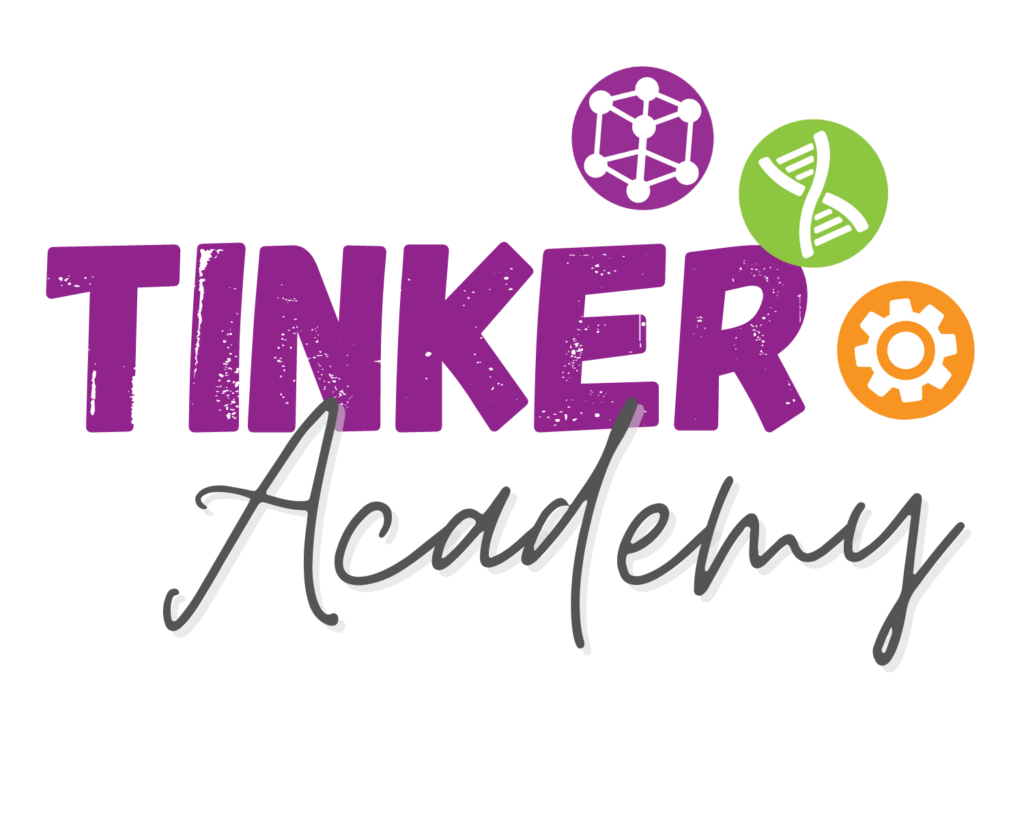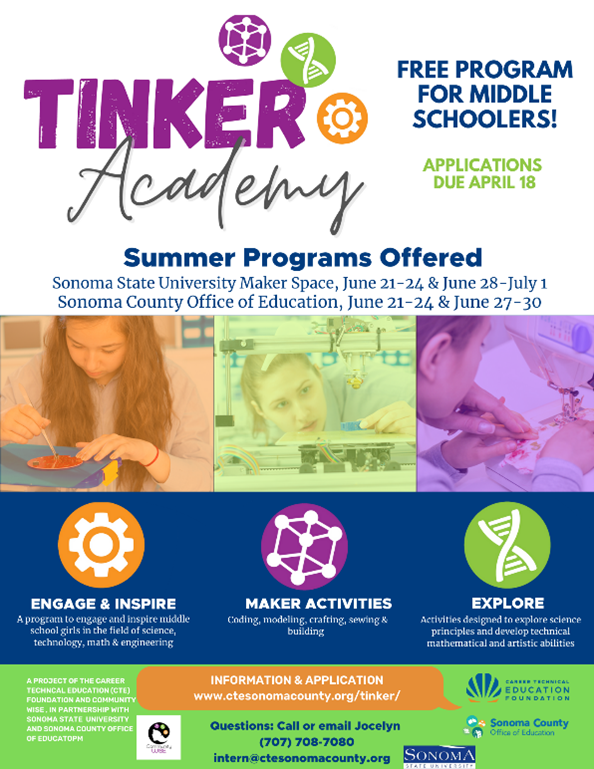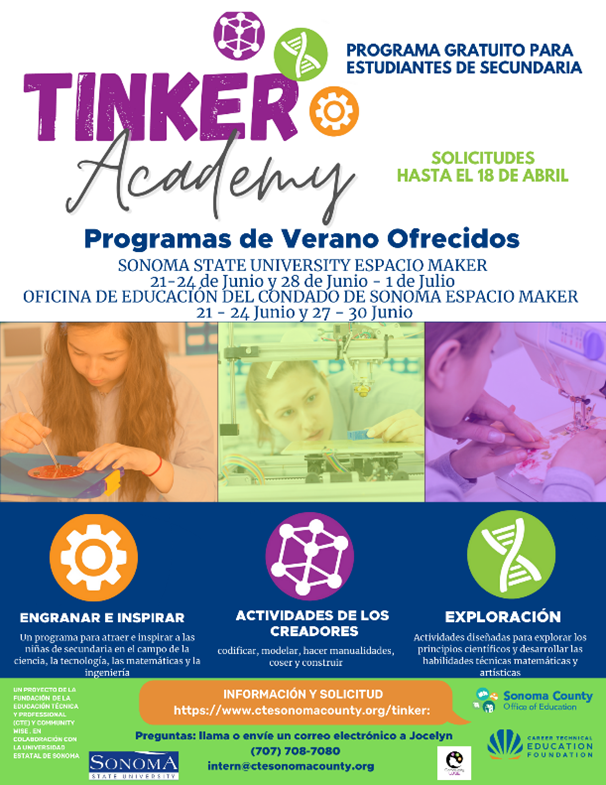Tinker Manual:
Program Details

Developing Your Program: Contents
Tinker Program History
In 2016, the Career Technical Education (CTE) Foundation Sonoma County, in partnership with several local organizations and women leaders, formed a leadership group to address the gender gap for girls and women in pursuit of Science, Technology, Engineering and Math (STEM) education and careers. As a result, Community WISE was formed.
Community WISE (Women Investing in STEM Equity) was founded on the belief that STEM workforce challenges can only be solved by diverse partners collaborating to create disruptive solutions promoting equity for all girls. Formally launched in 2017, Community WISE began as a coalition of local employers, education institutions, students and community members that invests in learning opportunities that support an ecosystem of positive interventions to inspire and prepare young women and girls in the pursuit of STEM education and careers.
Since 2018, CTE Foundation’s flagship investment has been what began as the Girls Tinker Academy, the only free STEM-focused summer camp for middle school girls in Sonoma County. Developed in partnership with Sonoma State University, the program is designed to inspire and encourage girls in this critical age group to stay engaged in math and science through hands-on, relatable projects. The two-week program teaches STEM skills through maker activities, including coding, robotics, 3-D modeling and crafting.
Expanding diversity in STEM
Since 2019, the program’s goal to increase diversity in the STEM workforce has expanded. While we started with prioritizing girls in STEM, the pursuit to increase the number of girls of color participating in our programs has deepened. In 2021, strategic marketing plan to focus outreach at schools with greater than 50% Latino/a population was implemented. In addition, materials available in Spanish were created and distributed. Staff members were available to support Spanish-speaking parents. Radio commercials ran on local Spanish-language radio stations and had support from nonprofit organizations serving the targeted population. As a result, the program has seen a steady increase in the ethnic and racial diversity of program participants.
“Girls” or not?
This program was originally developed for girls and called the “Girls Tinker Academy.” Since 2021, “girls” was dropped from the name of the program in response to public concern that the program was discriminatory. Sonoma State University then asked to have “girls” eliminated from the title to address the complaint and enable them to implement it on campus.
Internally, CTE Foundation and the Community WISE advisory struggled with this decision – and the reason for it. The program was designed to provide a safe space for girls to explore, fail and gain confidence in STEM. The data has proven that girls don’t feel included in our current STEM classrooms and jobs.
At the same time, the Community WISE advisory had already taken on design work in 2020 to examine the language used in the program. In the advisory’s vision, mission and other language words “woman” and “girl” were used frequently. The group asked, “What’s been important about using language that includes “women” and “girls” in our initiative?” The advisory determined:
- The Community WISE mission originally aligned with data available regarding the gender gap in STEM.
- Studies showed that girls build confidence when they in a group with all the same gender; the advisory wanted to create and provide a safe space for girls to fully express themselves.
- The advisory wanted to create a program and space and develop camaraderie among women supporting other women.
- There is comfort in “sameness.”
The advisory also wondered, “Why might it be important to think more expansively about the language we use?” At a crucial moment in history (post-George Floyd’s murder in June 2020) the advisory looked more carefully and proactively at what inclusion and privilege mean. The advisory did not want to exclude important voices in the programs or in the future of STEM.
Interesting statistics about gender identity today:
- Most millennials and Gen Z see gender as a spectrum, rather than as binary.
- 56% of Gen Zers know someone who uses a gender-neutral pronoun.
- 12% of millennials identify as transgender or gender non-conforming.
- 25% of Gen Zers expect to change their gender identity at least once in their lifetime.
While there are many benefits to having a girls-only program, the aim of the program is not to be exclusionary. In fact, the reason for the program is to make the world of STEM more inclusive.
For now, CTE Foundation has dropped “girls” from the program title, but it remains the intent to provide programming targeted at young people who are not represented in STEM. While each organization or program has its own strategic goals that may direct how a Tinker Academy program is named, CTE Foundation recommend developing program marketing materials that are inclusive and let applicants know that the program is open to middle school students including gender-expansive youth.
Partnership with Educational Institutions
A partnership with Sonoma State University’s School of Science & Technology was formed in 2016 to design the program and implement. An associate math professor was recruited to pilot the program, and it launched with great success in 2017. The program further expanded through a partnership with the local Sonoma County Office of Education to double capacity in 2022.
These partnerships have been crucial for ensuring the curriculum aligns to Next Gen Science Standards and addresses the needs of our participants. Partnerships were structured such that CTE Foundation provided fundraising, marketing and administrative support while the educational institution provided maker equipment and supplies, appropriate space and staffing for the program.
Program Budget
The program has always been offered to students free of charge and is fully funded through gifts (donations) from individuals, businesses and foundations. Fundraising needs vary greatly depending on in-kind support offered from partnering organizations and other grants or donation support an organization is able to generate.
Sample Program Budget
This sample budget covers a base program but program budgetsvary greatly depending on hourly rates, facility costs, etc.
Item | Cost | Description/Comments |
Implementation Cost | $ 40,000.00 | Teacher/site staffing; speaker honorariums; supplies; snacks |
Advertising & Promotion | $ 10,000.00 | Radio ads; social media; sponsorship of events and/or community tabling; video/photo to use in recruitment/promotion/fundraising |
Photography & Video | $ 4,000.00 | |
Student Outreach | $ 5,000.00 | Contract(s) with other organizations to support outreach, primarily with Latinx Communities |
Train-the-Trainer | $ 4,000.00 | Stipends for new/future Tinker leads; stipend for trainer; food |
Program Administration Staffing | $ 15,600.00 | Intern @ 15 hours/week, 760 hours/9 months @ $20/hour |
$ 26,000.00 | 5 hours per week @ $100/hour; Management Program oversight, design/implementation, fundraising support | |
Total | $ 104,600.00 |
Application Process
Program participants are chosen through a competitive process where application reviewers are guided by the goal of creating a diverse group of participants as determined by the middle school applicant’s expressed passion for STEM and making, enthusiasm for the academy, and demographic representation. The guiding principle is to provide a space for girls who might not otherwise have an opportunity to explore and create within the context of STEM in hopes of generating confidence and motivation for future study.
To ensure access to a diverse group of students, the Tinker Academy actively seeks participants from traditionally underserved populations and is offered free of charge so that ability to pay does not prohibit anyone from exploring STEM education and careers. As a result, the program attracts many students from low-income families who normally cannot participate in STEM enrichment programs due to prohibitive costs.
Designing the Application (with equity/accessibility in mind)
The program application has evolved since the first program in 2018. While different applications have been tested, program application elements typically:
– Encourage the student to complete the application (in lieu of the parent).
– Ask questions to try and understand the student’s passion for STEM.
– Allow students to answer their questions in written form or by providing an audio or video submission
CTE Foundation has used Google Forms to collect application data. Other options have been researched but Google Form has the fewest barriers (it is free and most middle schoolers already use Google Suite in school). Tip: Many school networks do not allow students to access external sites; if a teacher or school staff is helping a student complete the application, they may hit a firewall.
Over the years, more and more funders are requiring organizations to report data on specific demographic data (race, ethnicity, gender and/or household income). While reluctant to collect that data in the early years, CTE Foundation has started requesting this data from guardians although it is not required.
Teacher Recommendation
CTE Foundation’s program requires a teacher recommendation from each applicant.
On the application form, the applicant provides the recommender’s name, email address and phone number. A short form is then sent out via email for the recommender to complete. (Provide sample form)
This form has also been modified over the years based on program and data collection needs. Most recently, the following question was added: “Generous donations and grant support allow us to currently offer this program free to students. We would like to prioritize access for students who wouldn’t normally be able to participate in extra-curricular STEM programs due to cost or other barriers. Would you recommend we prioritize this applicant?” While an answer was not mandatory, this question did help prioritize and/or understand the student’s lived experience a little better from the perspective of the recommender.
Best practices:
– Provide a PDF copy of what is on the application so students, parents and/or educators know what to expect and how long the application is.
– Ask for demographic data as needed, but don’t make it mandatory.
– Choose an application tool with the fewest barriers for the target audience.
– Provide paper copies of the application as needed.
– Follow up to request/remind about teacher recommendations as early as possible.
Application Review
Tinker Academy applications are reviewed by teams with a minimum of two participants; CTE Foundation recommends a combination of organization staff and volunteers.
Application sets are created using mail merge with the aim of removing as much identifying information as possible regarding gender, etc.
Applications are assigned randomly to teams. The members of the team typically review and score the application individually, then come together to deliberate and determine which they “highly recommend,” “recommend,” or those who are “not recommended.”
The group then gathers once again to review results and decide on a pool of highly recommended applicants. Staff may need to adjust based on spots available in each session; ensure gender equity; and ensure the demographic matches our public-school demographic in our community.
Communication with Applicants and Parents
Once the participants have been selected, a confirmation email and a confirmation form are sent to selected participants; in this form, updated information is gathered such as additional demographic info, photo releases and other items. It is best to collaborate with the educational institution to collect data they may need as well. Set a deadline for a response and if a participant does not complete the form, begin working through the waitlist.
Sample email to Application Reviewers
Thank you for agreeing to be part of the review process for this year’s Tinker Academy. We have a total of XX applications to review and just XX spots available. You have been divided into X review teams; most teams have someone who has been part of the reviewing process – please consider them a great resource. Your team should have X applications to review.
IMPORTANT: While this program is open to all students, it is designed to support populations that are not represented in STEM fields; see the attached fact sheet for more information about representation in STEM. Please consider this in your evaluation.
Instructions:
- Review the applications assigned to your team via the links below. Application materials are two parts:
- Application form info combined with the recommendation from a teacher. If there is no data in there, that means we did not receive a teacher recommendation. We are still receiving these and will update you if we receive them.
- Personal statement – applicants had the option to provide written, audio or video files. If you can’t find the statement, it means the student did not submit it (but feel free to double-check with us).
- Utilize the rubrics : these help guide your recommendations (we will incorporate the numerical result, but it will not be the ONLY thing to determine final recommendations).
- Meet briefly with your team member (emails above for you to set up a Zoom or phone call prior to compare notes and prepare recommendations/suggestions), and talk through/discuss your recommendations.
- Submit a JOINT team rubric by EOD on [INSERT DATE] for each applicant (please be sure to include the applicant number) by either emailing us or including in your folder.
Important: Because we can only invite XX participants, I need you to do the HARD WORK and provide the following in your rubrics:
– X highly recommend; X recommend; X not recommend
– If you end up with more or less than the recommended numbers, I encourage you to talk through with your teammate and/or reach out to me or Jocelyn to talk through!
Here are our review teams and the links take you to the folders containing the application and the supplemental portion:
Team 1: Team Member Names
Team 2: Team Member Names
Team 3: Team Member Names
Team 4: Team Member Names
So, link up with your teammate ASAP and set a time to pick your recommended students.
Don’t hesitate to reach out to me with any questions.
Sample Email to Accepted Applicants
Dear Tinker Academy applicant,
Congratulations! On behalf of [YOUR ORGANIZATION], we welcome you to join the Tinker Academy [INSERT SESSION NAME OR DATES], at [INSERT LOCATION].
At the Tinker Academy, you will:
- Learn principles of math, science and technology through a variety of fun activities including coding, modeling, crafting, sewing and building.
- Be inspired to exercise your creativity and problem-solving skills.
- Meet and interact with other students who enjoy math, science, technology, art and making – just like you!
- Meet women leaders in STEM and Making areas.
- Create and take home your own projects.
** IMPORTANT ** To secure your spot in the [SESSION NAME], click on this Google Form to review the Program Expectations, Code of Conduct and Liability disclosures. You MUST submit the Confirmation Form by the end of the day on [INSERT DATE].** This will allow us to extend the opportunity to students on the Wait List if you are not able to commit.
The instructor for the academy will be in contact with you a couple weeks before your session to check in and introduce herself and provide you with more information about where to go, what to expect, etc.
Again, congratulations. We look forward to meeting you soon!
Sample Email to Wait List
Thank you very much for your interest in the Tinker Academy. After a very challenging review process, you have been placed on the Wait List. We hope you continue to seek out opportunities to explore STEM!
We received nearly 2x the applications than we have seats available in the program, and the Review Committee had to make difficult choices in selecting participants among the many highly qualified applicants. By placing your application on the Wait List, you will be immediately notified if a spot becomes available in the program.
We encourage you to apply again next year if you are still eligible. If you would like specific feedback about your application, you may submit an inquiry to me and we will do our best to answer your questions.
Marketing & Outreach
This program is free and therefore demand will always outpace available spots in the program. That said, the aim is to have a pool of applicants whose identity matches that of the local public-school population. In Sonoma County community, this means targeted outreach must be done to ensure that Latinx families and/or those parents who speak primarily Spanish in their home are reached.
Marketing assets
- Flyer (available in both English and Spanish)
- Website (English/Spanish)
- Postcards for distribution at events w/ QR code
- Social media posts
- Quotes and/or stories from previous applicants
- Short blurb for school or other community newsletters
Marketing tools/vehicles
- Radio advertising (in Sonoma County, Spanish-language radio is prioritized)
- Social media
- Organization e-newsletter
- School newsletter or e-blasts
- Emails to teachers
- Attendance at teacher staff meetings, STEM-focused meetings or STEM-related classrooms
- Attendance at community events that are STEM-focused and/or serve target audience (= middle school students)
Since 2021, CTE Foundation’s program has employed a part-time program assistant/intern who is bilingual and bicultural in Spanish to support outreach, marketing and program administration. The program assistant supported Spanish-speaking parents, attended events and outreach in both English and Spanish. In addition, the program assistant was a college student studying STEM, which allowed potential applicants to “see themselves” in this person. We highly recommend employing this type of outreach model in other communities.
Sample Timeline
Date | Activity |
January | Pre-outreach with schools – Try and get invited into classrooms or staff meetings for mini-presentations – Provide materials for sharing in school/district newsletters, etc. – Identify list of STEM teachers and/or advocates for e-blast |
Finalize the application & process – Update application as needed – Finalize program timeline | |
Develop/finalize marketing plan and materials – Individualized outreach to targeted schools – Develop/update flier – Ensure materials looks good in Spanish (including website) – Update website – Send email outreach to all previous Tinker participants – | |
February 15 | Application period opens; Promotion begins |
February/March | Mostly digital promotion: newsletter announcement, social media, emails to STEM teachers, get the announcement into other organization newsletters |
In-person Outreach – Visit classrooms – Attend youth-serving or STEM focused events – Q&A sessions or Zoom office hours for parents | |
April 1 | Applications due |
April 8 | Teacher recommendations due |
April 10-24 | Application Review by volunteer teams |
April 24-30 | Final review by staff |
May 1 | Applicants notified |
May 15 | Applicants accept; wait list notified as needed |
June 15 | Program begins |
Sample Flyers


Program Evaluation
Our program has implemented several different methods for evaluation.
Teacher Evaluation
After each program, we request a grant/program report from the teacher instructor. The report covers:
- Program description/overview
- Program successes
- Program challenges/how would you improve these challenges?
- What modifications would you recommend?
- What feedback did you receive from techs, participants, or parents?
- What would you do differently next time?
This provides valuable feedback to our organization as the funder and helps us continue improving and refining the program.
Student Evaluation/Student Surveys
There have been a range of student conducted. In 2023, both pre- and post-surveys with participants were conducted. These surveys aim to get direct feedback on the program and track and skill building from the program.
Surveys with participants six months or even longer after their participation have been conducted. These surveys aim to capture persistence in STEM in high school (and beyond).
